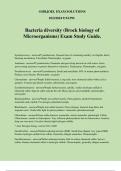©SIRJOEL EXAM SOLUTIONS
10/3/2024 9:54 PM
Bacteria diversity (Brock biology of
Microorganisms) Exam Study Guide.
Synechococcus - answer✔Cyanobacteria. Unusual form of swimming motility, no flagella, direct
thrusting mechanism. Unicellular. Phototrophic, oxygenic
Anabaena - answer✔Cyanobacteria. Dominate nitrogen fixing bacteria in cold waters. Form
spore resting structures to protect themselves (akinetes). Filamentous. Phototrophic, oxygenic
Prochlorococcus - answer✔Cyanobacteria. Small and unicellular. 80% of marine photosynthesis.
Produce toxic blooms. Phototrophic, oxygenic
Chromatium - answer✔Purple Sulfur bacteria. Long rods, store elemental sulfur within cell as
granules. Contain specialized vacuoles. phototropic, anoxygenic
Ectothiorhodospora - answer✔Purple Sulfur bacteria. spirilla. oxidize hydrogen sulfide to
elemental sulfur. Deposit sulfur outside the cell. Many species also halophilic. phototrophic,
anoxygenic
Rhodospirillum - answer✔Purple non-sulfur bacteria. Pink pigment, alcohol fermentation.
Anaerobic and colorful. Fix nitrogen. photoheterotroph.
Rhodobacter - answer✔Purple non-sulfur bacteria. Fixes nitrogen, found in deep lakes and
stagnant water. Needs little light for photosynthesis. Anaerobic, photoheterotroph
Chlorobium - answer✔Green sulfur bacteria. nonmotile, strictly anaerobic, phototroph. Utilize
Chlorosomes, similar to chloroplasts. Very efficient photosynthesis due to chlorosomes, found in
deep sea vent areas. Can also tolerate high hydrogen sulfide.
* Also Nitrogen fixing, convert N2 to NH3
Desulfovibrio - answer✔Sulfate reducing bacteria (SRB). Small bean shaped, very typical SRB.
Produce hydrogen sulfide from sulfate. Generally obligate anaerobes. Chemotrophic.
Desulfuromonas - answer✔Sulfur reducing bacteria Able to reduce elemental sulfur, but not
sulfate. Reduce elemental sulfur to hydrogen sulfide. Chemotrophic, generally obligate anaerobe.
, ©SIRJOEL EXAM SOLUTIONS
10/3/2024 9:54 PM
Acidithiobacillus - answer✔Sulfur oxidizing bacteria (SOB). Require oxygen, obligate aerobe.
Chemolithotroph. Can separate Iron from sulfur, leading to acid mine damage. "Bio leaching", or
separating of metals using bacteria rather than chemicals.
Beggiatoa - answer✔Sulfide oxidizing bacteria. Neutrophile. Chemotrophic, obligate aerobe.
Convert hydrogen sulfide to elemental sulfur. Filamentous, tufts that are anchored in water. Store
sulfur granules. To prevent autoxidation, split up process by storing mixture.
Thiomargarita - answer✔Sulfide oxidizing bacteria. Neutrophile. Chemotrophic, obligate aerobe.
Convert hydrogen sulfide to elemental sulfur. Very large bacteria! Store large vacuoles of NO3-,
couple Ammonia production with sulfide oxidation. Prevent autoxidation by separation over
time.
Mesorhizobium - answer✔Nitrogen fixing bacteria. Chemotrophic. Anaerobic, live in soil.
Contains nitrogenase, which is inhibited by oxygen. Lives around roots of legumes. Convert N2
to NH3. Diazotroph, forms symbiotic relationship with plants.
Klebsiella - answer✔Nitrogen fixing bacteria. Chemotrophic. Anaerobic, live in soil. Contains
nitrogenase, which is inhibited by oxygen. Regulate nitrogenase use by only fixing Nitrogen if
growing anaerobically (No oxygen present).
Azotobacter - answer✔Nitrogen fixing bacteria. Chemotrophic. Anaerobic, live in soil. Contains
nitrogenase, which is inhibited by oxygen. Free living diazotroph, randomly in soil. Produces a
giant slime capsule to prevent unwanted interactions with oxygen.
Nitrosomonas - answer✔Nitrifying bacteria. Chemotrophic. Produce Nitrate (NO3-). Reduce
inorganic N-compounds. Two kinds, Nitrosomonas is an Ammonia oxidizer. Converts NH3 to
NO2- (ammonia to nitrite). Contains mono-oxygenate, found in sewage and soil.
Nitrobacter - answer✔Nitrifying bacteria. Chemotrophic. Produce Nitrate (NO3-). Reduce
inorganic N-compounds. Two kinds, Nitrobacter is a nitrate oxidizer. Converts NO2- to NO3-
(Nitrite to Nitrate). Ability comes from possible horizontal gene transfer.
Paracoccus - answer✔de-nitrifying bacteria. Chemotrophic. Destroys nitrate (NO3-). Grows by
anaerobic respiration, releases N2, N2O or NO as byproducts. Causes lose of precious Nitrite in
fertilizers. Can also grow off of H2, very good at conserving energy. Produces hydrogenase
enzymes. "Explosive" properties
*Has excessive non-photosynthetic membranes
Methylobacter - answer✔Methylotrophic bacteria. Uses organic acids, ethanols and sugars for
growth. Unable to use methane. Often found in open oceans, can growth off of methanol.




